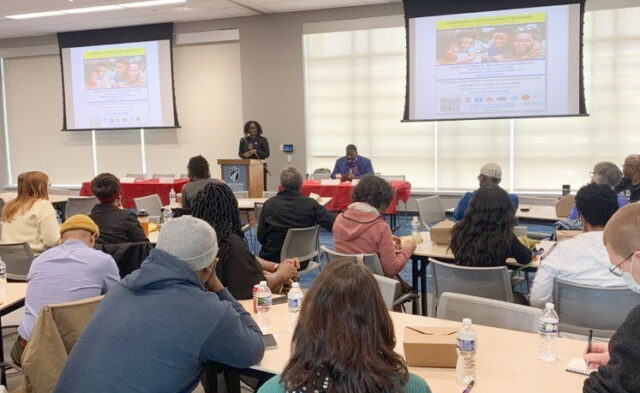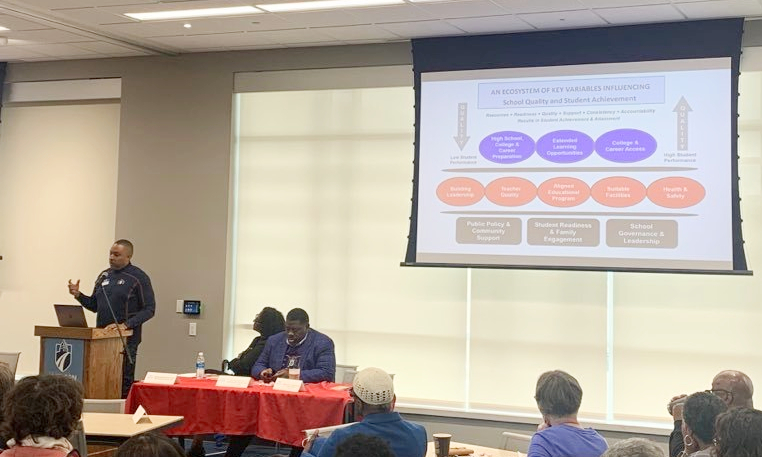
Parents, educators, community members, and Black leaders in Madison met for a “State of Black Students at MMSD” event at Madison College South Campus on April 29. The event, put together by Kirbie Mack, vice president of Blacks for Political and Social Action of Dane County (BPSADC), invited anyone concerned about the racial gaps in achievement or the experiences of Black students in the Madison Metropolitan School District to come to discuss issues affecting their families.
Reverend David Hart, BPSADC president, gave an opening message calling into question what happens between the doors of the home and the doors of the school. While post-COVID education has been difficult for students, educators, and families across the board, Madison’s gap in educational outcomes between its Black and white residents runs deeper than the recent pandemic.
While BPSADC hosted the community engagement session, it was truly a community effort with many local sponsors that included the Madison Metropolitan School District, African American Council of Churches, Urban League of Greater Madison, Madison Alumni Chapter of Delta Sigma Theta Sorority Inc, 100 Black Men of Madison, JFMJ Academy, Boys & Girls Club of Dane County, United Way, and the NAACP of Dane County.
Danielle Y. Hairston-Green, who was the emcee of the event, set the goal for everyone present.
“We can complain because it’s our right to express our concerns, but if you really want change to happen, you have to be a part of it … physically getting dirty in the trenches of making change happen,” Dr. Hairston-Green said to open the event. “We know change is hard for anyone. We will follow change if we trust the changemakers.”
What was confirmed by One City Schools CEO Kaleem Caire is a current difficulty with basic needs and structure that drive impactful education. Caire also raised attention to a national gap in an area that was consistently mentioned throughout the day — reading. While the solutions Caire gave were complex and multi-dimensional, the most important factors were in both academic readiness and making sure children are ready to be behaved and structured in school.
“You can make sure that your child adjusts appropriately from being in your home, where they’re the center of your attention and joy, to a space with 20 other kids where they compete for attention, and then behaviors show up,” said Caire, reflecting on readiness, attendance, and resource gaps that are also felt at One City Schools, even with a greater focus on equitable experiences for students of color.
“School is not a place that fixes kids and it’s not a place that raises kids, it’s a place that educates kids…but with them, we can actually raise children together.”
These same sentiments were felt by parents who were able to voice concerns in breakout sessions. Sessions were split into elementary, middle, and high school, and topics ranged among them with general questions of positives, negatives, and changes that could be made. These topics, among others, were then discussed by a panel hosted by Angela Arrington consisting of Madison Metropolitan School District Superintendent Carlton Jenkins, MMSD Associate Superintendent of Middle School Education Angie Hicks and Middleton-Cross Plains Area School District Director of System Improvement Percy Brown Jr.
At the elementary level, parents discussed issues such as nutrition and engagement between students as areas that could be worked on. The importance of children getting to know each other, especially in diverse settings with children who do not look like them, was centered as an issue that carries on throughout Madison as well as the significance of culturally relevant teachings and understanding. While some parents were happy with the amount of engagement they received from their elementary schools, many were also concerned for working parents and wondered what resources were available, such as after-school programs, to help them.
Parents were also concerned with a drop in communication once reaching middle school. They reported hearing less communication about their children’s progress and needs once their students reached middle school. Although reading and school readiness at home were mentioned as crucial aspects of school success, barriers to parents trying to get involved proved to be a gap in understanding and communication between schools and families. Many participants discussed solutions and methods of acclimating parents to today’s schools and schooling so that families themselves have a better grasp on just how important their child’s education is.

At the high school level, expectations and opportunities were discussed as community members lamented how the schools themselves, and even sometimes the families, can resign themselves to lower expectations for their Black and brown students. Solutions such as more diversity in teaching and mentoring opportunities for Black students were considered. Parents talked about the difficulty in attracting Black educators to Madison permanently. They settled on the facts that while there can be more organizing and efforts done by families and community members to demand Black students’ needs be met, there would have to be changes beyond the schools to close racial achievement gaps.
The State of Black Students at MMSD proved to be a hard event for many attendees as discussed problems draw closer to being out of control. What was certain is that there is a greater need in the Madison area for attention to gaps in experience overall among people of color, especially Black residents. Black students and residents alike experience the doubt, undermining, and questioning that is ever-present when they do call attention to experiences of racism, and these responses certainly have a deep effect on Black students’ perception of MMSD and the Madison area, in general.



























